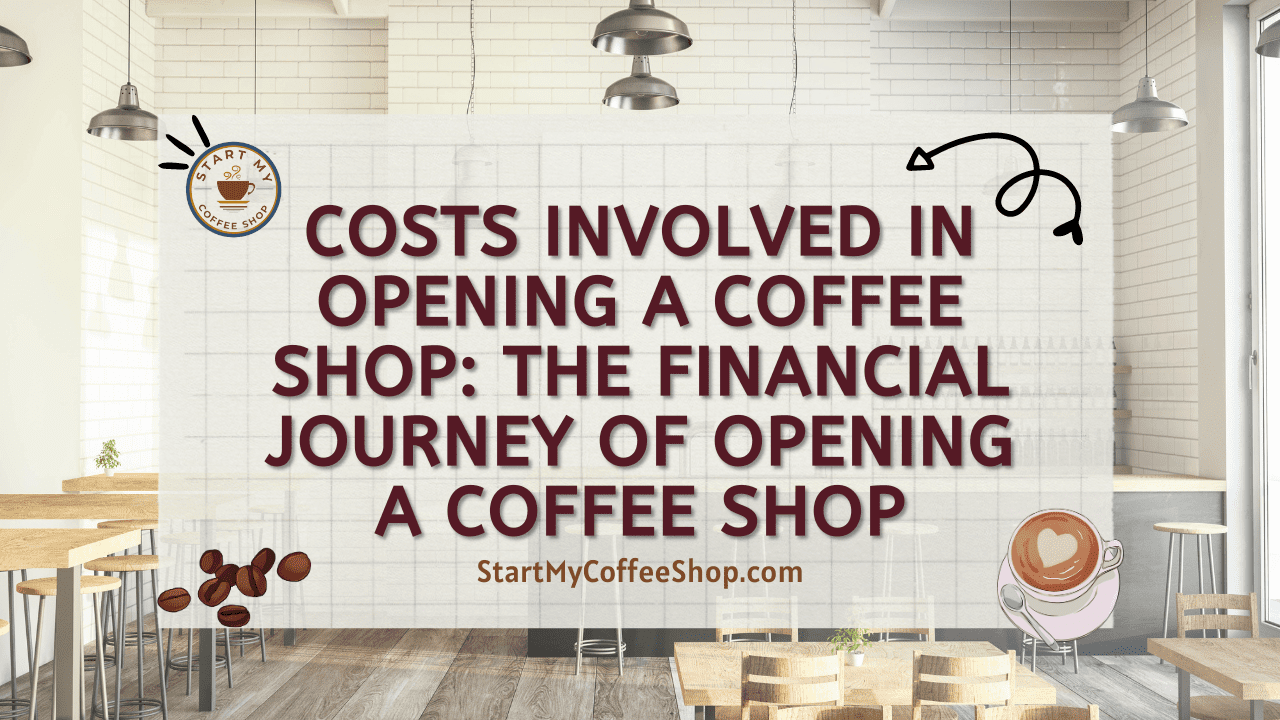The aroma of freshly brewed coffee, the warm ambiance, and the opportunity to create a community hub are all appealing aspects. However, it’s crucial to understand that there are various costs involved in turning this dream into reality.
Opening a coffee shop entails costs such as location expenses, equipment and furnishings, licensing and permits, staffing, supplies, marketing, utilities, and insurance. Proper financial planning is essential for a great venture.
In this article, I will delve into the often-overlooked expenses and factors you need to consider before opening your coffee shop.
1. Location
 Selecting the perfect location for your coffee shop is a critical factor that can significantly impact its progress. While prime locations can offer excellent visibility and high foot traffic, they often come with a substantial price tag. Rental costs vary based on factors like the city, neighborhood, and the level of foot traffic in the area.
Selecting the perfect location for your coffee shop is a critical factor that can significantly impact its progress. While prime locations can offer excellent visibility and high foot traffic, they often come with a substantial price tag. Rental costs vary based on factors like the city, neighborhood, and the level of foot traffic in the area.
To navigate this challenge, thorough research and negotiation skills are key. Take the time to explore different neighborhoods, comparing rental prices and analyzing their potential customer base. Carefully consider how the location aligns with your target market and business plan.
In addition to rental costs, you should also factor in potential renovation expenses. Adapting the space to suit your coffee shop’s needs and branding may require renovations, such as installing plumbing, electrical work, or interior design changes. Your overall budget should account for these costs to avoid any unexpected financial strain.
By conducting extensive market research and carefully considering both rental and renovation costs, you can make an informed decision about the location of your coffee shop. Balancing affordability with strategic positioning will set a solid foundation for your business’s long-term growth.
2. Equipment and Furnishings
 Investing in the right equipment and furnishings is crucial to creating a coffee shop that delivers exceptional coffee and provides a welcoming atmosphere for customers. High-quality machines, grinders, and espresso makers are essential for achieving consistent and flavorful coffee.
Investing in the right equipment and furnishings is crucial to creating a coffee shop that delivers exceptional coffee and provides a welcoming atmosphere for customers. High-quality machines, grinders, and espresso makers are essential for achieving consistent and flavorful coffee.
However, it’s important to note that such equipment can come with a significant price tag, particularly if you opt for top-of-the-line brands known for their precision and durability.
Beyond the coffee-making equipment, don’t overlook the costs associated with furniture and seating. Comfortable chairs, tables, and cozy seating areas are vital for creating an inviting ambiance that encourages customers to linger and enjoy their beverages. Additionally, consider the cost of display cases to showcase your delectable pastries and treats, as well as appropriate lighting to enhance the overall aesthetics of your space.
When budgeting for equipment and furnishings, strike a balance between quality and affordability. Research different brands and suppliers, comparing prices and customer reviews to ensure you make informed choices. Consider both the immediate costs and the long-term durability and functionality of the items you select.
3. Licensing and Permits
Ensuring that your coffee shop operates within the legal framework is essential, and obtaining the necessary licenses and permits is an important aspect of this process. The specific licenses and permits required for a coffee shop vary depending on your location and local regulations.
Common permits include those for food service, health inspections, signage, and outdoor seating if applicable. Each permit may involve different application fees and inspection requirements. It’s crucial to research the specific regulations in your jurisdiction to understand the costs involved.
Application fees can range from modest to substantial, depending on the region and the complexity of the permit. Additionally, some permits may require recurring fees for renewals or ongoing inspections to ensure compliance with health and safety standards.
To accurately estimate the costs of licenses and permits, consult with local government authorities or licensing agencies. They can provide detailed information regarding the specific requirements and associated expenses. Factoring in these costs during your financial planning phase will help you avoid surprises and ensure that your coffee shop operates legally and smoothly from the start.
Read more about Cost to Start Coffee Shop Business: The Unfiltered Finances
4. Staffing
When calculating the costs involved, it’s crucial to consider various factors. Firstly, account for the expenses associated with the recruitment and training of competent baristas, supervisors, and support staff. This includes advertising job openings, conducting interviews, and providing initial training.
Beyond recruitment and training, allocate funds for ongoing expenses such as salaries, benefits, and payroll taxes. Salaries may vary depending on experience and location, so conduct market research to ensure competitive compensation. Benefits, such as health insurance, retirement plans, and paid time off, are important for attracting and retaining quality employees.
Additionally, investing in employee development programs and training initiatives can contribute to the long-term progress of your coffee shop. Continual improvement and enhancing employees’ skills can elevate the quality of service and coffee, resulting in increased customer satisfaction and loyalty.
Remember to factor in the costs of workers’ compensation insurance and other relevant insurance to protect both your employees and your business.
5. Supplies and Inventory
When considering the costs involved, it’s important to calculate the ongoing expenses of replenishing your inventory. Prices of coffee beans, syrups, and other ingredients can fluctuate due to factors like seasonality and market conditions. Staying aware of these fluctuations is crucial for managing your profit margins effectively.
Proper inventory management is essential to ensure a steady supply of fresh products while avoiding waste. Regularly monitoring your inventory levels, tracking expiration dates, and implementing efficient ordering processes can help maintain optimal stock levels and minimize costs.
To control costs and ensure product quality, consider negotiating favorable pricing and payment terms with your suppliers. Additionally, explore options for bulk purchasing or joining purchasing cooperatives to leverage buying power and potentially secure better deals.
6. Marketing and Advertising
To effectively attract customers and establish a strong presence in the competitive coffee industry, investing in marketing and advertising is crucial. When considering the costs involved, there are several aspects to take into account.
Firstly, developing a compelling brand identity that resonates with your target audience is essential. This includes creating a captivating logo, selecting a cohesive color scheme, and crafting a unique brand voice. Collaborating with professional designers or agencies may be necessary, and their services will need to be factored into your budget.
In today’s digital age, a well-designed website is a necessity. Budget for website development, including hosting fees and ongoing maintenance costs. Consider hiring a professional web designer or utilizing website builders to create an engaging online presence that showcases your coffee shop’s offerings, location, and story.
Social media platforms provide excellent opportunities to engage with customers and promote your coffee shop. Allocate resources for social media campaigns, content creation, and community management. You may also consider utilizing paid advertising on social media platforms to expand your reach.
While digital marketing is crucial, don’t overlook the potential of traditional advertising channels. Allocate a portion of your budget for print media advertisements, billboards, or other forms of offline promotion if they align with your target audience and local market.
Engaging in local community events, partnering with other businesses, or sponsoring relevant activities can also boost your visibility. While these collaborations may involve additional expenses, they offer the opportunity to connect with the community and create a positive brand image.
Marketing is an ongoing effort, and it’s important to regularly evaluate the effectiveness of your strategies and adjust accordingly. By investing in a comprehensive marketing plan, you can effectively reach your target audience, differentiate your coffee shop from competitors, and cultivate a loyal customer base.
7. Utilities and Operational Expenses
Operating a coffee shop requires careful consideration of ongoing expenses beyond the initial investment. Utility costs, including electricity, water, gas, and internet services, are crucial to keep your business running smoothly.
Depending on the size of your establishment and the equipment used, these expenses can accumulate and impact your bottom line. It is particularly important to factor in these costs if your coffee shop has extended operating hours or offers additional services like food preparation.
In addition to utilities, other operational costs must be taken into account. Investing in a reliable and efficient point-of-sale system is essential for smooth transactions and accurate record-keeping. This includes not only the hardware but also any necessary software licenses for inventory management, sales tracking, and customer relationship management.
Maintaining a clean and hygienic environment is vital for any coffee shop. Budgeting for cleaning supplies, including detergents, sanitizers, and paper products, is necessary to ensure a safe and pleasant experience for your customers and staff.
General maintenance should also be considered, including the upkeep of equipment, plumbing, and fixtures. Allocating funds for repairs, servicing, and preventive maintenance will help minimize unexpected downtime and ensure the longevity of your assets.
It’s important to regularly review and track these ongoing expenses to identify areas where cost savings can be made without compromising the quality of your services. Analyzing utility usage, exploring energy-efficient options, and comparing prices from different suppliers can help optimize costs in the long run.
Read more about Cost to Start Drive-Thru Coffee Shop: A Cupful of Expenses
8. Insurance and Legal Fees
Ensuring the protection of your coffee shop from potential liabilities is of utmost importance. One key step in this regard is obtaining the necessary insurance coverage. General liability insurance shields your business from claims related to accidents, injuries, or property damage that may occur on your premises. It provides financial protection and helps cover legal expenses if a lawsuit is filed against your coffee shop.
Workers’ compensation insurance is essential if you have employees. It provides coverage for medical expenses and lost wages in the event of work-related injuries or illnesses. This insurance not only safeguards your employees but also protects your business from potential lawsuits arising from workplace incidents.
Property insurance is crucial to safeguard your coffee shop against unexpected events such as fire, theft, or natural disasters. It provides coverage for the physical structure, equipment, inventory, and other assets, ensuring that you can recover financially in the event of a covered loss.
Consulting with a lawyer or legal professional is advisable to review contracts, agreements, and leases to ensure they are legally sound and protect your interests. They can help identify potential legal risks and provide guidance on how to mitigate them.
Summary
Opening a coffee shop requires careful financial planning and a thorough understanding of the costs involved. By considering factors such as location, equipment, licensing, staffing, supplies, marketing, utilities, and insurance, you can better prepare yourself for the journey ahead.
Remember, each coffee shop is unique, and costs may vary depending on your specific vision and goals. With a well-researched business plan and a focus on customer satisfaction, your coffee shop can thrive in this vibrant industry. Cheers to your coffee shop adventure!
Frequently Asked Questions
1. What are the typical costs involved in opening a coffee shop?
Opening a coffee shop involves expenses such as rent, equipment, licensing, staffing, supplies, marketing, utilities, and insurance.
2. How much does it cost to lease a suitable location for a coffee shop?
The cost of leasing a location for a coffee shop can vary widely depending on factors like the city, neighborhood, and size of the space.
3. What equipment is necessary for a coffee shop, and how much does it cost?
Essential equipment for a coffee shop includes coffee machines, grinders, espresso makers, refrigeration units, and more. Costs can range from a few thousand dollars for essential equipment to tens of thousands for high-end, professional-grade machinery.
To learn more on how to start your own coffee shop checkout my startup documents here
Please note: This blog post is for educational purposes only and does not constitute legal advice. Please consult a legal expert to address your specific needs.

Hi! I’m Shawn Chun
My adventure in coffee began when I first launched my first coffee shop back in the early 2000s. I had to figure out so many things on my own and to make it worse within 2 years of opening two large corporate coffee chains moved in just blocks away from me!
As I saw smaller and even some larger coffee shops in the neighborhood slowly lose customers to these giant coffee chains and slowly close up shop, I knew that I had to start getting creative…or go out of business.
I (like you may be) knew the coffee industry well. I could make the best latte art around and the foam on my caps was the fluffiest you have ever seen. I even had the best state-of-the-art 2 group digital Nuova Simonelli machine money could buy. But I knew that these things alone would not be enough to lure customers away from the name brand established coffee shops.
Eventually, through lots of trial and error as well as perseverance and creativity I did find a way to not only survive but also thrive in the coffee/espresso industry even while those corporate coffee chains stayed put. During those years I learned to adapt and always faced new challenges. It was not always easy, however, in the end, I was the sole survivor independent coffee shop within a 10-mile radius of my location. Just two corporate coffee chains and I were left after that year. All told the corporate coffee chains took down over 15 small independent coffee shops and kiosks and I was the last one standing and thriving.
Along the years I meet others with the same passion for coffee and I quickly learned that it is not only “how good a barista is” that makes a coffee shop successful, but the business side of coffee as well.
Hence why I started this website you are on now. To provide the tools and resources for up and coming coffee shop owners to gain that vital insight and knowledge on how to start a coffee shop successfully.
Stick around, browse through my helpful blog and resources and enjoy your stay! With lots of LATTE LOVE!
Shawn






